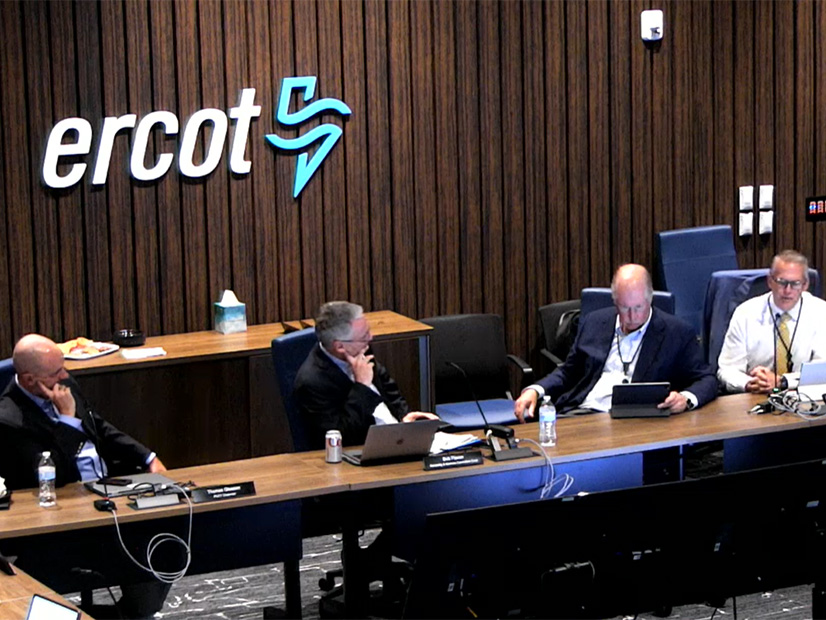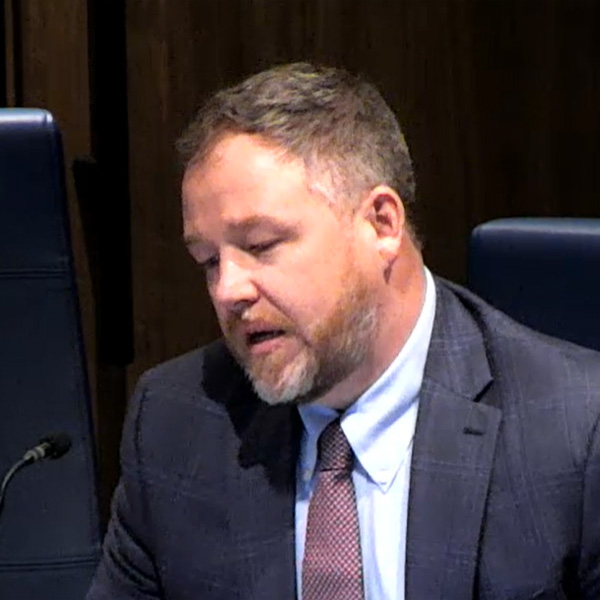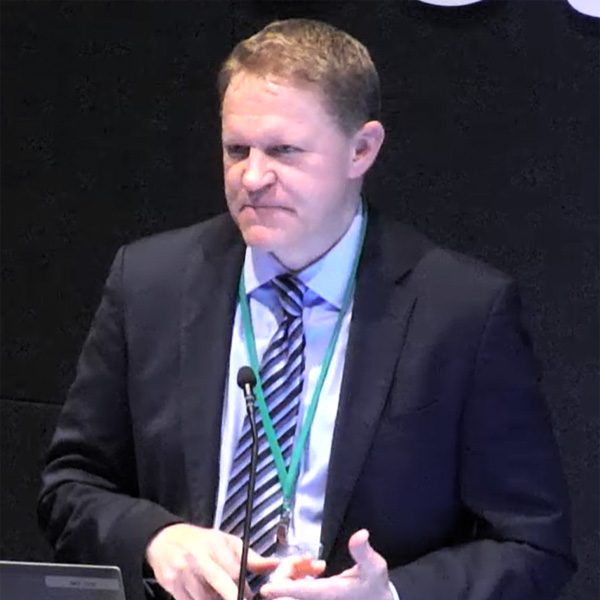
Contentious NPRR Revising ECRS Passes over Monitor’s Objections
ERCOT’s Board of Directors took up two contentious protocol changes during its June 18 meeting that have divided staff and stakeholders, tabling one it had previously remanded and approving the other over objections from consumer interests and the Independent Market Monitor.
Potomac Economics President David Patton made his second appearance in less than six months before board members to press his case against the grid operator’s heavy use of ERCOT contingency reserve service (ECRS).
Patton, whose firm holds ERCOT’s IMM contract, said he was “very disappointed” with the board’s approval of the protocol change (NPRR1224). The rule change sets a price floor of $750/MWh for the product, which procures capacity resources that can be brought online within 10 minutes and sustained at a specified level for two consecutive hours.
“This is the first time I’ve seen [a grid operator] advocate for such a proposal that is designed to undermine the competitive performance of its market — reducing reliability to artificially inflate its real-time prices,” Patton told RTO Insider.
The Monitor last year said the ECRS product, ERCOT’s first new ancillary service in 20 years, created artificial supply shortages that produced “massive” inefficient market costs totaling about $12 billion during the year. The service was first deployed in June. (See ERCOT Board of Directors Briefs: Dec. 19, 2023.)
“I think this is one of the most important votes to approve something that you’ll ever take,” Patton told the board’s Reliability and Markets Committee on June 17. “The key objectives of any competitive, deregulated wholesale markets is that they produce efficient and competitive outcomes that maintain the reliability. NPR1224 violates all three of those objectives.”
In his presentation to the committee, Patton said NPRR1224 will effectively have ERCOT administer a withholding framework where key economic units are physically withheld from the real-time market until they are deployed. He said it economically withholds the resources after deployment by attaching the $750 offer floor, “for which there is no competitive basis.”
Because ERCOT doesn’t yet co-optimize energy and ancillary services in real time (that is scheduled to come online in 2026), ECRS is quarantined from the real-time market. The Monitor projects that if conditions this year are similar to 2023’s, the NPRR will generate “inefficient and anticompetitive” costs exceeding $5.7 billion. Patton recommended staff instead develop procedures that would anticipate a security-constrained economic dispatch (SCED) shortage and then deploy ECRS.
Attorney Katie Coleman, who represents Texas Industrial Energy Consumers, advocated for a $100 price floor but supported 1224 as an interim step before real-time co-optimization (RTC) is added to the market.
“We are concerned that with the $750 price floor, we are not making much progress relative to last summer’s experience,” she said. “We do support a stopgap between now and real-time co-optimization to insulate the market from those effects, but we believe that the $100 floor is the appropriate level.”
ERCOT staff said they had drafted another protocol change (NPRR1232) as a follow-up to NPRR1224. It would introduce a mechanism to make some ECRS available to SCED every hour, assuming the latter NPRR’s price floor is codified into the protocols. Staff said the price floor represents the opportunity cost of depleting available reserves for use in the real-time market.
Staff said ECRS has been deployed 52 times through May 2024, with 43 of those occasions providing frequency recovery or to cover net load ramps. ERCOT CEO Pablo Vegas used that data point in supporting NPRR1224, which he said is intended to provide some benefits during the summer.
NPPR1224 “represents an improvement over what we saw last year in terms of lowering the price,” Vegas said. “The [Technical Advisory Committee] has worked together to try to find a pathway that addresses some of the cost implications that we saw last summer. It preserves the unique characteristics of ECRS and what we’re able to do under manual deployments today with our control room. It represents the first step in a series of … steps that are going to track us towards RTC.
“I would recommend we move forward with the work that TAC has done and take this first step to see the benefit this summer. We’ll be able to take continued lessons learned into 1232 as we set up the automation of the release of ECRS. We’re going to have to get comfortable as a committee and as a board dealing with issues where there are strong pros and strong cons. We’re not going to be able to necessarily find the middle ground that makes everybody happy on these kinds of issues.”
The R&M Committee, divided over the deliberative stakeholder process and a lack of transparency into the price floor, voted 3-1 to approve NPRR1224. The Office of Public Utility Counsel’s CEO, Courtney Hjaltman, cast the dissenting vote over concerns the price floor is too high. She abstained from the full board’s unanimous vote.
NOGRR245 Bifurcated, Delayed
The board also agreed with staff’s recommendation to table a revision to the Nodal Operating Guide (NOGRR245) that has been bandied back and forth between stakeholders and staff since late last year. The proposed rule change would impose voltage ride-through requirements on inverter-based resources.
Staff said tabling the measure will give them additional time to hammer out an agreement with some stakeholders by bifurcating or decoupling parts of the exemptions and extension process for legacy assets unable to meet ride-through requirements.
“ERCOT believes one more opportunity to work with joint commenters is appropriate to potentially give regulatory certainty,” staff said.
General Counsel Chad Seely said ERCOT will work to schedule a special board meeting before the regular Aug. 19-20 bimonthly meetings to take up NOGRR245’s exemptions and extension process issues. He said that will allow staff to quickly hand off the measure to the Texas Public Utility Commission for policy discussions. The measure’s reliability assessment process and criteria for hardware upgrades necessary to meet its requirements will go through the normal stakeholder process, with a December target to go before the board.
“This is a critical reliability issue for the grid. It’s time to move this forward and hand this off to the commission as expeditiously as possible,” Seely said, expressing optimism that staff will be able to “effectively bifurcate” the issue.
TAC endorsed the rule change June 7 after several months of trading and reviewing comments with ERCOT, gaining staff’s support in the process. The committee inserted gray-box language with potential modifications that wouldn’t become effective until March 2025. The language was aimed at those entities for which upgrade costs are less than 40% of the full, in-kind replacement cost of a plant’s inverters or turbines and converters. (See ERCOT TAC Endorses Rule for Inverter-based Resources.)
However, the joint commenters — primarily renewable developers — protested the change and threatened to file a complaint at the PUC, saying TAC attempted to defer issues around hardware changes by placing them in the gray-box language. They urged the board to ensure that the ride-through standards “do not have the unintended consequences of harming reliability by eliminating existing generation and harming future investment in infrastructure in the ERCOT market.” (See Renewable Developers Oppose Proposed ERCOT IBR Rule.)
The NOGRR is meant to align the grid operator’s protocols with NERC reliability guidelines and the most relevant parts of the Institute of Electrical and Electronics Engineers’ standard for IBRs interconnecting with the grid. The board in April remanded the NOGRR back to TAC, directing that the language be modified to address ERCOT’s reliability concerns.
ECRS Slows Energy Prices’ Drop
ERCOT IMM Director Jeff McDonald said that while he wasn’t going to focus on ECRS in briefing the board, the ancillary service had a profound effect on the market last year.
“I know it comes up repeatedly in the report … but you will see it is the focus in certain areas in the report because it had a fairly profound effect on energy prices and overall cost,” he said in sharing the Monitor’s annual State of the Market report.
McDonald said the load-weighted average energy prices were down about 13% to roughly $65/MWh in 2023 from the year before, even though natural gas prices declined more than 60% during the same period. The report attributes that difference to the “adverse” effects of ECRS’ implementation, noting that real-time prices drive those in the day-ahead and forward markets.
“Electricity prices will be correlated with natural gas prices in a well-functioning market because fuel costs represent the majority of most suppliers’ marginal production costs, and natural gas units are generally on the margin in ERCOT,” the report says.
ECRS’ effect on real-time prices was largely confined to the hotter months of June through September, McDonald said. “So, it did roughly double the real-time energy price during that period.”
McDonald said the IMM spent a “fair amount” of time looking at the market’s competitiveness, finding it to be competitive with little evidence that suppliers exercised market power. He said that while the market has provided sufficient revenues to signal the need for more generation in four of the past six years, he was unable to explain why it took the subsidization of gas plants’ construction through the Texas Energy Fund to make that more of a reality. (See Vistra Joins Rush for Dispatchable Generation Loans.)
“As a project developer, you need to see a series of revenues in the market that would support your investment before you undertake it,” he theorized. “In the investment world, policy risk is a big factor, especially for large capital … investments. So I’ll be spending more time trying to find a satisfactory answers to your question.”
ERCOT: Another Hot Summer
Dan Woodfin, ERCOT’s vice president of system operations, told the board that staff meteorologists expect this summer to be among the hottest on record, as have the past few summers.
“Probably not as hot as last summer, where we just had lots and lots of hot temperatures,” he said. “We’ve actually had quite a few of the summers within the last few years that have been well above normal, and so we expect this summer to fit in with that. Given what we’ve seen in June, I think that we’re trending that way.”
“We’re seeing a pretty significant little bit higher growth during the summer period than what we’ve seen in some of the other seasons,” CEO Vegas said. “It’s a little bit higher than what we’ve seen across other seasons over that same period, and it’s likely due to the very hot summers recently that we’ve just had. So we’ve seen some very recent high weather that has helped to boost some of the demand growth.”
According to a recent University of California, Berkeley study, the state’s average temperature has risen by about 2.7 degrees Fahrenheit since the dawn of the industrial age. However, the heat index has been as many as 11 degrees higher during that same period.
The past two summers have been the second- and third-hottest on record, and four of the 10 hottest summers have come in the past six years, Vegas said. September 2023 was the hottest September on record and included ERCOT’s first energy emergency since the disastrous February 2021 winter storm.
ERCOT set a new demand market record last August of 85.5 GW during a summer in which it issued 17 weather watches, voluntary conservation notices or conservations appeals. As of June 20, it was projecting more than 80 GW of demand on June 26, marking the first 80-GW day of the season. The June record for peak demand came last year at 80.8 GW.
“We are prepared for this summer,” Vegas said, citing weatherization inspections, “meaningful” growth in generation resources and tabletop exercises.
2nd DR RFP Canceled
Vegas said ERCOT is canceling a request for four-hour demand response after it received three offers with less than 10 MW.
A request for 3,000 MW of six-hour DR last fall was canceled when the grid operator received 11.1 MW of potential eligible capacity.
“It is clear from the two recent experiences with capacity [requests for proposals] … that we need to modify the approach for developing the next set of demand response capabilities in the ERCOT market,” Vegas said, echoing similar comments he made last year. (See ERCOT Cancels RFP for Additional Winter Capacity.)
He added that he is confident there is “significant potential” in both residential and commercial and industrial demand response classes. “We need to take a more in-depth approach working with market participants to develop a demand response product that will be additive to the reliability capabilities at an ERCOT market level,” Vegas said.
ERCOT staff are working with PUC staff on a study Vegas said “shows meaningful potential for incremental demand response.” Texas A&M University is nearing completion of the study in advance of next year’s Texas legislative session, PUC Commissioner Kathleen Jackson said.
“Our stretch goal is that we want to look at the lay of the land and come up with recommendations that hopefully we can bring forth during the next legislative session,” Jackson said.
Board Approves $1.12B Project
The board approved ERCOT’s recommended $1.12 billion project to rebuild 345-kV infrastructure in West Texas that will address thermal overloads and petroleum production load-growth issues in the region. The project was also unanimously endorsed by TAC.
Oncor, the transmission provider, will disconnect existing 345- and 138-kV transmission lines before rebuilding about 245 miles of new line and switches. It will also build a new substation and upgrade terminal equipment. The utility plans to complete the work by summer 2028.
The board’s consent agenda included seven NPPRs, two NOGRRs and three revisions to the Planning Guide (PGRRs):
-
- NPRR1198, NOGRR258 and PGRR113: add an extended action plan as a constraint-management plan suitable to managing congestion resolvable by SCED.
- NPRR1212 and PGRR114: clarify a distribution service provider’s obligation to provide an electronic service identifier for a resource site that consumes load other than wholesale storage and is not behind a non-opt-in entity tie meter.
- NPRR1218: updates the state’s renewable energy credit trading program to clarify that it only applies to solar renewable energy.
- NPRR1220: modifies the market’s restart process to require board and TAC approval and provide an alternative mechanism to board approval under certain circumstances.
- NPRR1222: elevates final approval of the “ERCOT Methodologies for Determining Minimum Ancillary Service Requirements” other binding document from the board to the PUC, consistent with commission discussions.
- NPRR1223: updates a protocol form to require transmission and/or distribution service providers to provide contact information to ERCOT.
- NPRR1228: decreases the number of firm fuel supply service obligation periods awarded in a procurement from two to one.
- NOGRR255: establishes high-resolution data requirements.
- PGRR112: sets requirements for interconnecting entities to submit dynamic data models and for transmission service providers to submit final full interconnection studies for approval at least 30 business days before the quarterly stability assessment deadline.




